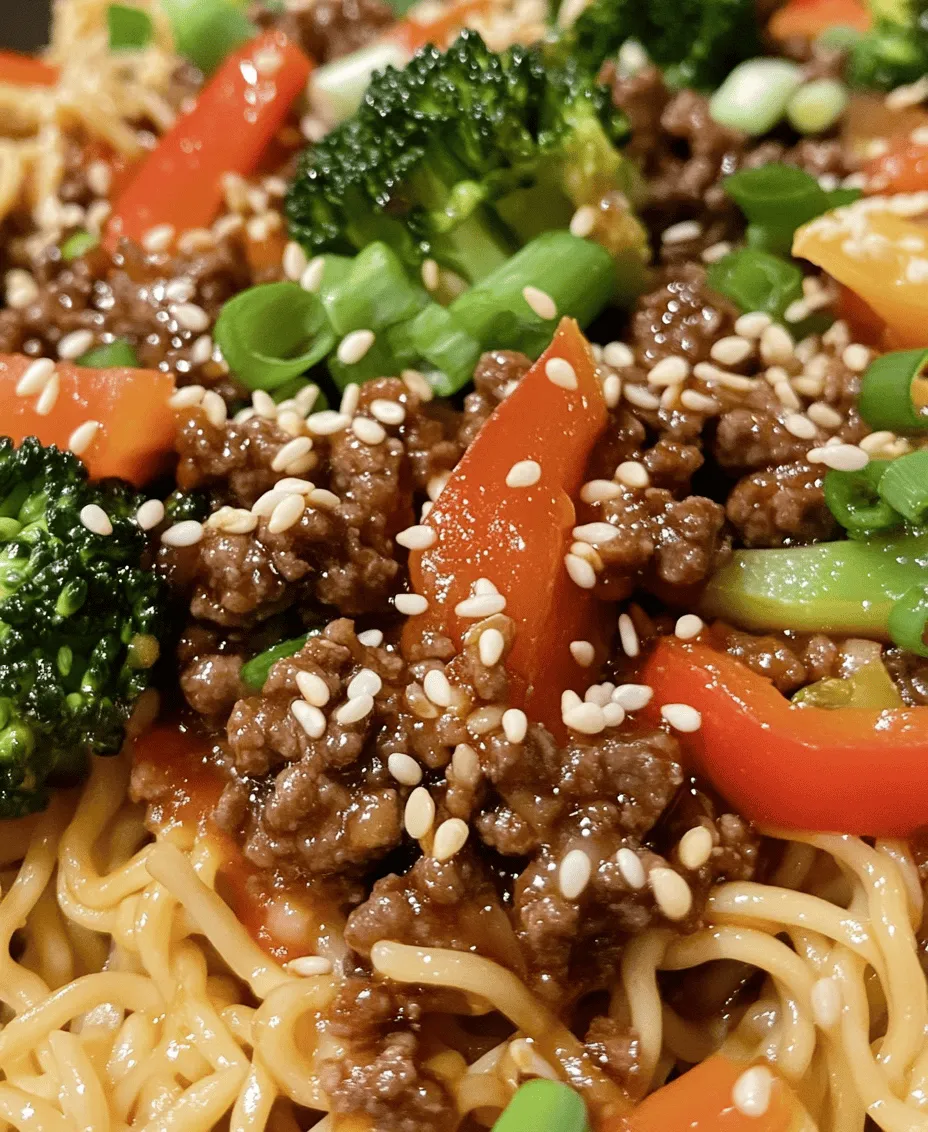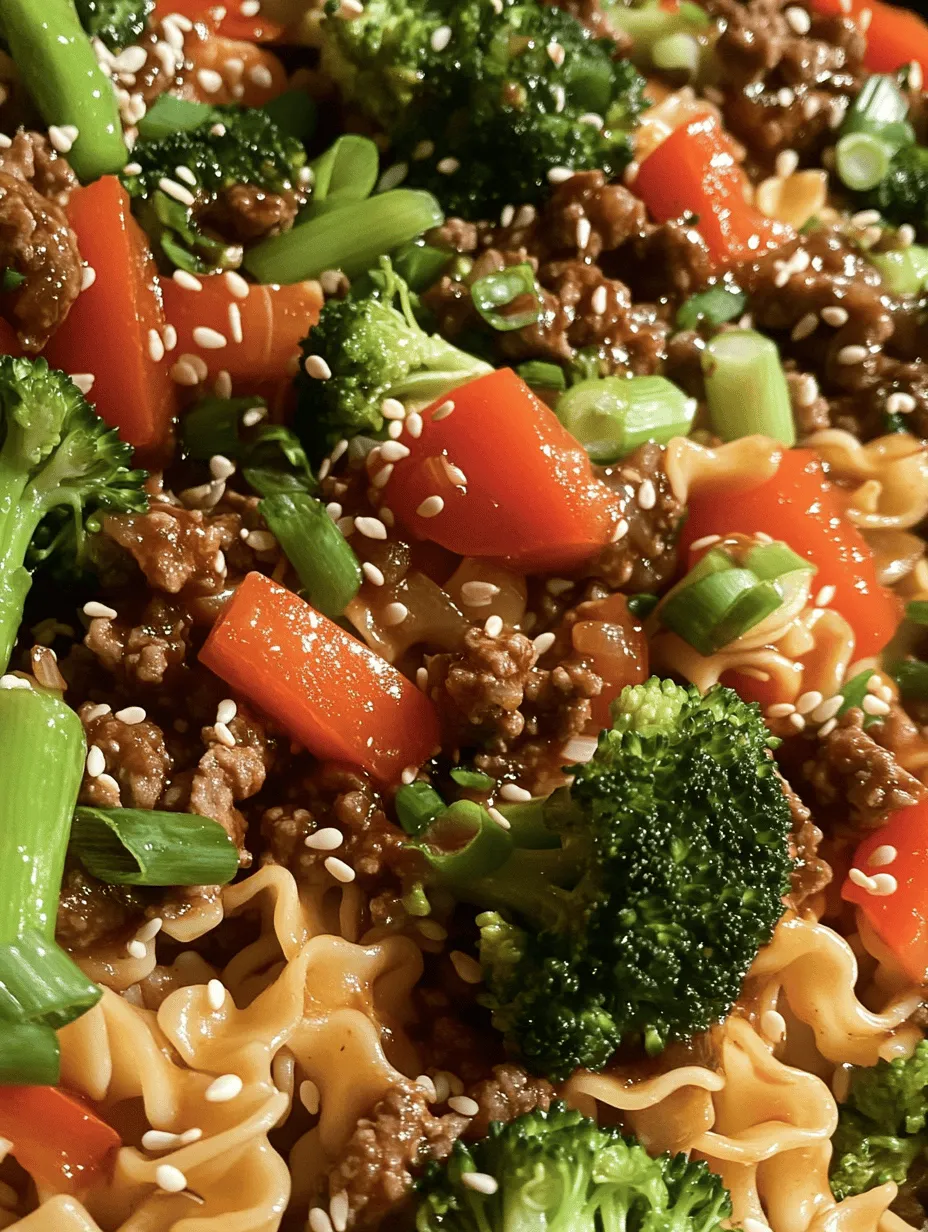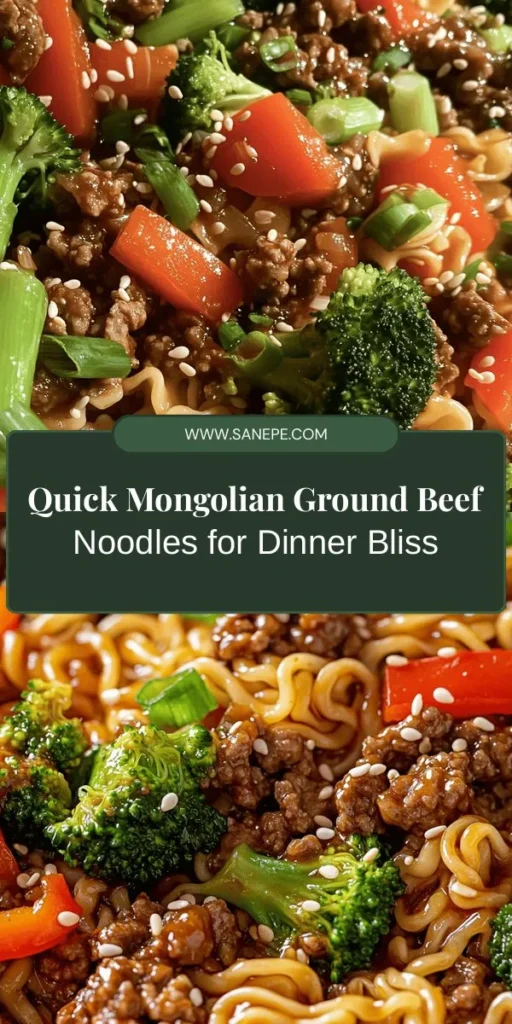Introduction
Discover the vibrant flavors of Mongolian cuisine with this stunning Mongolian Ground Beef Noodles recipe. Perfect for a quick weeknight dinner, this dish combines the richness of ground beef with the freshness of vegetables and the enticing aroma of garlic and ginger. With simple ingredients and a straightforward cooking process, you can enjoy a delightful and satisfying meal in just 30 minutes. This recipe not only brings together the essence of Mongolian flavors but also provides a nutritious and fulfilling option for busy evenings.
Mongolian cuisine is often characterized by its hearty and rustic nature, reflecting the nomadic lifestyle of its people. It emphasizes meat, dairy, and a variety of vegetables, making it both diverse and delectable. The use of noodles in Mongolian cooking adds a comforting element, making meals more filling and satisfying. Whether you are familiar with Mongolian food or trying it for the first time, this ground beef noodle dish is sure to become a family favorite.
Understanding Mongolian Cuisine
Exploring the Roots of Mongolian Cooking
Mongolian cuisine is a fascinating blend of flavors and techniques shaped by its geography and climate. The heart of Mongolian cooking lies in its reliance on meat, particularly lamb, beef, and horse, reflecting the country’s pastoral lifestyle. However, as globalization has grown, so has the incorporation of various ingredients, leading to diverse and flavorful dishes.
When it comes to the flavor profile, Mongolian dishes often feature bold tastes achieved through the use of garlic, ginger, onions, and various sauces. These ingredients not only provide depth but also enhance the overall aroma of the meal. The use of spices is generally moderate, allowing the natural flavors of the main ingredients to shine through.
The Role of Noodles in Mongolian Cuisine
Noodles hold a special place in Mongolian cuisine, serving as a staple carbohydrate that complements the rich proteins typical of the diet. They are often featured in traditional dishes, ranging from soups to stir-fries, and are cherished for their versatility. In Mongolia, noodles can be made from wheat flour, rice, or even buckwheat, and are often handmade, giving them a unique texture and taste.
This recipe for Mongolian Ground Beef Noodles highlights the importance of noodles in creating a balanced and filling dish. The noodles absorb the flavors of the beef and sauces, creating a delightful harmony in each bite.
The Cultural Significance of Noodles in Mongolia
Noodles are not just a food item; they are a symbol of nourishment and community in Mongolian culture. Traditional dishes featuring noodles, such as “buuz” (steamed dumplings) or “lamian” (pulled noodles), are often prepared during family gatherings and celebrations. The act of making noodles can bring families together, reinforcing bonds and traditions.
In Mongolia, noodles are celebrated for their ability to bring comfort and joy. Whether served at a festive occasion or as a daily meal, they represent a sense of home and hospitality. This cultural significance is reflected in the way Mongolians enjoy their food—often shared with friends and family around a communal table.
Ingredients Breakdown
Essential Ingredients for Mongolian Ground Beef Noodles
To create a truly stunning Mongolian Ground Beef Noodles dish, it is essential to use high-quality ingredients that enhance both flavor and nutrition. Here’s a breakdown of the key components:
– Ground Beef: The star of this recipe, ground beef provides a rich and savory base. Opt for grass-fed beef for its superior flavor and health benefits, including higher levels of omega-3 fatty acids and vitamins.
– Egg Noodles or Rice Noodles: These noodles serve as the foundation of the dish. Egg noodles are favored for their rich flavor and chewy texture, while rice noodles offer a lighter alternative. Choose based on your personal preference or dietary needs.
– Fresh Vegetables: Broccoli, bell peppers, and green onions not only add color but also nutritional value. These vegetables provide essential vitamins, minerals, and fiber, making the dish more balanced.
– Aromatics: Garlic and ginger are crucial for building flavor, infusing the dish with warmth and depth. These ingredients are well-known for their health benefits, including anti-inflammatory properties.
Exploring Flavor Enhancers
In addition to the primary ingredients, several flavor enhancers play a vital role in elevating this dish:
– Soy Sauce: A staple in many Asian cuisines, soy sauce adds umami and a savory depth. It enhances the overall flavor profile of the ground beef and noodles.
– Hoisin Sauce: This sweet and tangy sauce provides a unique flavor that complements the savory elements of the dish. It adds a layer of complexity that makes each bite more enjoyable.
– Sesame Oil: Just a drizzle of sesame oil can transform your dish. Its nutty flavor enhances the aroma and adds richness, making it a must-have in Mongolian cooking.
– Rice Vinegar: A dash of rice vinegar adds brightness and acidity, balancing the richness of the beef and sauces. It can help elevate the overall flavor, making the dish more refreshing.
– Brown Sugar: The subtle sweetness of brown sugar balances the saltiness of the soy sauce and hoisin sauce, creating a harmonious flavor profile.
Nutritional Benefits of Key Ingredients
Understanding the nutritional value of the ingredients can help you appreciate the health benefits of this dish:
– Broccoli: This superfood is rich in vitamins C and K, fiber, and antioxidants. Its inclusion not only boosts the nutritional value but also adds a satisfying crunch to the dish.
– Bell Peppers: Packed with vitamins A and C, bell peppers add vibrant color and sweetness. They are known for their health benefits, including supporting immune function and skin health.
– Green Onions: These aromatic vegetables provide a mild onion flavor and are low in calories. They are a great source of vitamins K and C, making them a healthy addition.
– Egg Noodles vs. Rice Noodles: While both types of noodles have their benefits, egg noodles are rich in protein due to the addition of eggs, whereas rice noodles are gluten-free and lighter. Your choice can depend on dietary preferences and nutritional goals.
Preparation Process
Step-by-Step Cooking Instructions
Now that you have an understanding of the ingredients and their significance, let’s dive into the preparation process. The following step-by-step instructions will guide you through creating your own stunning Mongolian Ground Beef Noodles:
1. Gather Your Ingredients: Before you start cooking, ensure you have all the necessary ingredients ready. This includes your choice of noodles, ground beef, vegetables, and all the flavor enhancers.
2. Cook the Noodles: Begin by bringing a large pot of salted water to a boil. Add the egg noodles or rice noodles and cook according to the package instructions. Aim for an al dente texture, as they will continue to cook when combined with the beef. Once cooked, drain the noodles and rinse them under cold water to stop the cooking process. Set aside.
3. Prepare the Vegetables: While the noodles are cooking, chop your vegetables. Slice the bell peppers into thin strips, and chop the broccoli into bite-sized florets. Thinly slice the green onions, separating the white and green parts.
4. Cook the Ground Beef: In a large skillet or wok, heat a tablespoon of sesame oil over medium-high heat. Add the ground beef to the pan, breaking it up with a spatula. Cook for about 5-7 minutes or until the beef is browned and cooked through. Drain any excess fat if necessary.
5. Add Aromatics: Once the beef is cooked, push it to the side of the pan and add the minced garlic and ginger. Sauté for about 30 seconds until fragrant, then mix it into the beef.
6. Incorporate the Vegetables: Add the chopped bell peppers and broccoli to the skillet. Stir-fry for 3-5 minutes until the vegetables are tender yet crisp.
7. Combine Noodles and Sauce: Add the cooked noodles to the skillet along with soy sauce, hoisin sauce, and brown sugar. Toss everything together to ensure the noodles are coated in the sauce and mixed with the beef and vegetables.
8. Finish with Green Onions: Sprinkle the white parts of the green onions into the skillet, reserving the green parts for garnish. Toss everything together for an additional minute.
By following these steps, you can create a delicious and visually appealing dish that showcases the vibrant flavors of Mongolian cuisine. As you enjoy your meal, you’ll appreciate not only the taste but also the cultural significance behind this hearty noodle dish.

Cooking Ground Beef to Perfection
Achieving the ideal browning of ground beef is crucial for the flavor and texture of your Mongolian ground beef noodles. To start, make sure your skillet or wok is hot before adding the beef. This high heat allows for a quick sear, which locks in juices and enhances the overall flavor. When you add the beef, break it apart gently with a spatula, spreading it evenly across the pan. Avoid overcrowding the pan, as this can lead to steaming rather than browning. If you’re cooking a large batch, consider doing it in two or more smaller batches.
Another important step is to drain excess fat from the cooked beef. While a little fat can add flavor, too much can make your dish greasy and unhealthy. Once the beef is browned, transfer it to a plate lined with paper towels to absorb any excess grease. This simple step ensures your noodles retain their intended texture and flavor without being weighed down by excess fat.
The Aromatic Base: Garlic and Ginger
Garlic and ginger are essential flavor builders in this recipe, providing depth and complexity to the dish. Their unique flavors not only enhance the ground beef but also complement the noodles and vegetables beautifully. To maximize their flavor, consider mincing the garlic and ginger finely. This increases their surface area, allowing for a more intense aroma and taste when they hit the hot oil in your pan.
Another technique is to sauté the garlic and ginger until fragrant before adding other ingredients. This method releases essential oils and aromatic compounds, creating a more robust base for your sauce and noodles. Be careful not to burn them, as overcooked garlic can become bitter, which could negatively impact the overall taste of your dish.
Creating the Perfect Sauce
The sauce is the heart of your Mongolian ground beef noodles, and balancing its flavors is key to achieving a harmonious dish. A standard sauce typically includes soy sauce, oyster sauce, and a hint of sweetness from sugar or honey. Start by mixing equal parts soy and oyster sauce, then add sugar to taste. If you prefer a bit of heat, consider incorporating chili paste or sriracha.
Taste your sauce as you go and adjust the ingredients based on your personal preferences. If you lean towards a saltier flavor, add more soy sauce. For a sweeter profile, increase the sugar or honey. The goal is to create a sauce that complements the beef and noodles while enhancing the overall dish without overpowering it.
Incorporating Fresh Vegetables
Adding fresh vegetables to your Mongolian ground beef noodles not only enhances the dish’s flavor but also adds color and nutrition. Some of the best vegetables to incorporate include bell peppers, carrots, snap peas, and bok choy. These vegetables provide a lovely crunch and vibrant color that contrast beautifully with the soft noodles and rich beef.
To retain their crunch and nutrients, it’s essential to use quick-cooking techniques. Stir-frying the vegetables for just a few minutes at high heat will keep them crisp while also ensuring they are cooked through. Aim to add them to the pan after the beef has been browned and the garlic and ginger have been sautéed. This timing allows the vegetables to absorb the flavors of the aromatic base while maintaining their fresh texture.
Combining All Elements for a Harmonious Dish
Once the beef, sauce, and vegetables are ready, it’s time to combine everything into a cohesive dish. Start by adding the cooked noodles to the skillet or wok, followed by the beef and vegetables. Use tongs or a spatula to gently toss everything together, ensuring each component is evenly coated with the sauce.
If the dish appears dry, you can adjust the sauce levels for your desired consistency. Consider adding a splash of water or broth to loosen it up, allowing the sauce to better envelop the noodles and beef. The final mix should be a harmonious blend of flavors and textures, with each bite showcasing the beef, vegetables, and noodles.
Serving Suggestions
Plating Your Mongolian Ground Beef Noodles
Presentation is key to enhancing the dining experience. When plating your Mongolian ground beef noodles, use a large serving bowl or individual plates for a more elegant touch. Start by twirling the noodles into a nest-like shape at the center of the plate, creating height and visual interest. Next, artfully arrange the beef and vegetables on top, allowing them to cascade down the sides of the noodles.
To elevate your dish further, don’t forget to garnish generously with chopped green onions and sesame seeds. The bright green onions add a pop of color and freshness, while sesame seeds provide a delightful crunch and nutty flavor. A drizzle of additional sauce can also enhance the visual appeal, making your dish look as good as it tastes.
Pairing with Complementary Dishes
To create a complete meal, consider pairing your Mongolian ground beef noodles with complementary side dishes. A simple cucumber salad dressed with rice vinegar and sesame oil adds a refreshing contrast to the rich noodles. Alternatively, spring rolls filled with fresh vegetables can provide a crunchy texture and lightness that balances the meal.
Beverage pairings can also enhance your dining experience. A light, crisp white wine such as a Sauvignon Blanc can complement the flavors of the dish without overpowering them. For a non-alcoholic option, consider serving iced green tea or a citrus-infused sparkling water, both of which can refresh the palate.
Conclusion
Embrace the bold and comforting flavors of this Mongolian Ground Beef Noodles recipe for your next dinner. With its easy preparation and delightful taste, this dish is sure to become a favorite in your household. Enjoy the perfect blend of textures and flavors, and savor the satisfaction of a quick yet fulfilling meal that pays homage to the rich culinary traditions of Mongolia. Whether you’re cooking for family or entertaining friends, these Mongolian ground beef noodles promise to impress and satisfy.

